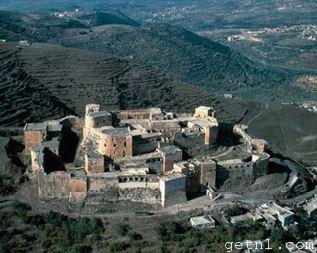The superb design and dramatic location of Syria’s Krak des Chevaliers, the finest Crusader castle ever built, puts the Tower of London in the shade

NEED TO KNOW
LOCATION Krak des Chevaliers is in western Syria, about 112 miles (180 km) north of the capital, Damascus ALTITUDE 2,500 ft (750 m) above sea level
DAYTIME TEMPERATURES
Jan: 54°F (12°C); Apr: 75°F (24°C); Jul: 97°F (36°C); Oct: 81°F (27°C)
“It is the Camelot of your dreams – the castle of every fairy tale.” So said the 20th-century British travel writer H. V. Morton of the mighty Krak des Chevaliers, which sits majestically high above the rolling plains of western Syria. This monumental castle, built by Crusaders in the 12th century, has often been likened to a ship, its prow nosing out high above a fertile expanse of vineyards, olive groves, farms, and villages.
Think of a medieval castle in Europe and you might picture a showpiece fortress, carefully preserved and protected, with pristine stonework and neatly mowed lawns. And if that fortress is at the heart of a city – as the once- prominent Tower of London is – it is likely to be dwarfed by glass-and-steel office buildings.
The cities these strongholds once dominated have now overpowered them. Yet in Syria, Krak des Chevaliers retains its rough-edged authenticity.Here, little attention has been given to modern ideas of commercialization, and the impressive structure still stands aloof – a bleak, brooding presence redolent with the ghosts of past battles.
The castle was expertly positioned atop a rocky spur that dominates the Homs Gap, the only break in the long chain of mountains that runs parallel to the coast from southern Turkey into northern Israel.
It thus dominated access routes between the Mediterranean coast and the Syrian interior, as well as the north-south passage between Damascus and Aleppo – lending it a strategic importance that remains as clear today as it did 900 years ago, unlike the Tower of London’s once-imposing Thames-side location.
The name Krak des Chevaliers, a mixture of Arabic and French, means “Fortress of the Knights.” In 1144, the local Crusader lord, Raymond II, Count of Tripoli, handed control of what was then a small, simple fortress to the Knights Hospitallers – a religious order that took on military duties in the Crusader realms (as did its contemporary, the Knights Templar).
The knights expanded the castle and added a 9-ft (3-m) thick encircling outer wall studded with towers to create a virtually impregnable ring of defenses, making it the Holy Land’s largest and most sophisticated stronghold.
Today, you cross the moat and climb a dark, twisting passage through to the inner courtyard, which contains a beautiful Gothic cloister and grand hall, complete with its original vaulting. Explore the Crusader kitchens and storerooms, the austere 12th-century chapel, the ramparts, and the Grand Master’s apartments in the highest tower, which have elegant Gothic windows offering commanding views. You’re likely to have the castle all to yourself.
Krak des Chevaliers was eventually taken in 1271 by the Mamluk Sultan Baybars. Around this time, Prince Edward of England was in the Holy Land as part of the Ninth Crusade and visited the castle. He returned home in 1272 and, as King Edward I, set about conquering Wales: the castles he built at Beaumaris, Caernarfon, Harlech, and elsewhere – with their concentric rings of defenses – were all modeled on the Syrian original.
FORGET THE TOWER OF LONDON?
THE BUILD-UP The Tower of London, which overlooks the River Thames in the center of the city, is a spectacular example of medieval military architecture. It embodies many of London’s most iconic images, from its resident ravens and famous “Beefeater” guards to the Crown Jewels.
THE LETDOWN This is one of the most popular attractions in Britain – more than two million people visit each year – so you can be sure you won’t be alone when you go. Adding insult to injury, there’s a hefty admission cost for both adults and children. Then there’s the lack of historical context: in 2006, UNESCO warned that it might add the Tower to its “at risk” list, because of the encroachment of unsightly modern office buildings on all sides.
GOING ANYWAY? Avoid the summer peak season (Jun–Aug), when the crowds can be stifling. If you can, visit on weekdays and plan to arrive at 9am, when the Tower opens – but nonetheless be prepared to find yourself at the center of a tourist maelstrom.
PRACTICAL INFORMATION
Getting There and Around
The nearest international airport to Krak des Chevaliers is at Damascus, the Syrian capital, from where buses and trains run north to the city of Homs. From here, “microbuses” (vans) run frequently to the castle.
Where to Eat
The popular Al-Kalaa restaurant stands on the next hilltop along from Krak des Chevaliers. It’s a simple place serving standard Syrian cuisine, including salads and grilled-meat kebabs, and has spectacular views of the castle.
Where to Stay
Within walking distance of the castle is the fine Al-Wadi Hotel. Its attractive, Oriental-style guest rooms have a touch of class, and many have balconies with fabulous views of the castle silhouetted against the sky.
When to Go
The best seasons to visit Syria are spring (Mar–May) and fall (Sep–Nov), when you’ll find the surrounding hills carpeted with wildflowers and lush vegetation.
Summer temperatures are scorching and winters can be chilly, with rain and often snow.
Budget per Day for Two
You could get by on as little as US$60–75, though US$150 is more realistic.